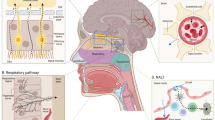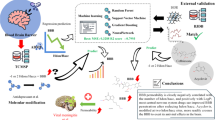Abstract
Geissoschizine methyl ether (GM) in Uncaria hook, a galenical constituent of yokukansan is thought to be one of active components in the psychotropic effect of yokukansan, a traditional Japanese medicine (kampo medicine). However, there is no data on the blood–brain barrier (BBB) permeability of Uncaria hook-derived alkaloids containing GM. In this study, we investigated the BBB permeability of seven Uncaria hook alkaloids (GM, isocorynoxeine, isorhynchophylline, hirsuteine, hirsutine, rhynchophylline, and corynoxeine) using in vivo and in vitro methods. In the in vivo experiment, seven alkaloids in the plasma and brain of rats orally administered with yokukansan were measured by liquid chromatography–mass spectroscopy/mass spectrometric multiple reaction monitoring assay. In the in vitro experiment, the BBB permeability of seven alkaloids were examined using the BBB model composed of co-culture of endothelial cells, pericytes, and astrocytes. In the in vivo study, six components containing GM but not isocorynoxeine were detected in the plasma, and three (GM, hirsuteine, and corynoxeine) of components were detected in the brain. The in vitro BBB permeability data indicated that seven alkaloids were able to cross brain endothelial cells in culture conditions and that the BBB permeability of GM was higher than those of the other six alkaloids. These results suggest that target ingredient GM in yokukansan administered orally is absorbed into the blood and then reaches the brain through the BBB. This evidence further supports the possibility that GM is an active component in the psychotropic effect of yokukansan.



Similar content being viewed by others
References
Abbott NJ, Ronnback L, Hannson E (2006) Astrocyte–endothelial interactions at the blood–brain barrier. Nat Rev Neurosci 7:41–53
Cecchelli R, Berezowski V, Lundquist S, Culot M, Renftel M, Dehouck MP, Fenart L (2007) Modelling of the blood–brain barrier in drug discovery and development. Nat Rev Drug Discov 6:650–661
De Vries HE, Blom-Roosemalen MCM, De Boer AG, Van Berkel TJC, Breimer DD, Kuiper J (1996) Effect of endotoxin on permeability of bovine cerebral endothelial cell layers in vitro. J Pharm Exp Ther 277:1418–1423
Dehouck MP, Jolliet-Riant P, Brée F, Fruchart JC, Cecchelli R, Tillement JP (1992) Drug transfer across the blood–brain barrier: correlation between in vitro and in vivo models. J Neurochem 58:1790–1797
Deli MA, Ábrahám CS, Kataoka Y, Niwa M (2005) Permeability studies on in vitro blood-brain barrier models: physiology, pathology and pharmacology. Cell Mol Neurobiol 25:59–127
Gaillard PJ, De Boer AG, Breimer DD (2003) Pharmacological investigations on lipopolysaccharide-induced permeability changes in the blood–brain barrier in vitro. Microvasc Res 65:24–31
Iwasaki K, Satoh-Nakagawa T, Maruyama M, Monma Y, Nemoto M, Tomita N, Tanji H, Fujiwara H, Seki T, Fujii M, Arai H, Sasaki H (2005a) A randomized, observer-blind, controlled trial of the traditional Chinese medicine Yi-Gan San for improvement of behavioral and psychological symptoms and activities of daily living in dementia patients. J Clin Psychiatry 66:248–252
Iwasaki K, Maruyama M, Tomita N, Furukawa K, Nemoto M, Fujiwara H, Seki T, Fujii M, Kodama M, Arai H (2005b) Effects of the traditional Chinese herbal medicine Yi-Gan San for cholinesterase inhibitor-resistant visual hallucinations and neuropsychiatric symptoms in patients with dementia with Lewy bodies. J Clin Psychiatry 66:1612–1613
Joό F (1996) Endothelial cells of the brain and other organ systems: some similarities and differences. Prog Neurobiol 48:255–273
Kanno H, Sekiguchi K, Yamaguchi T, Terawaki K, Yuzurihara M, Kase Y, Ikarashi Y (2009) Effect of yokukansan, a traditional Japanese medicine, on social and aggressive behaviour of para-chloroamphetamine-injected rats. J Pharm Pharmacol 61:1249–1256
Kis B, Deli MA, Kobayashi H, Ábrahám CS, Yanagita T, Kaiya H, Isse T, Nishi R, Gotoh S, Kangawa K, Wada A, Greenwood J, Niwa M, Yamashita H, Ueta Y (2001) Adrenomedullin regulates blood–brain barrier functions in vitro. Neuroreport 12:4139–4142
Mizukami K, Asada T, Kinoshita T, Tanaka K, Sonohara K, Nakai R, Yamaguchi K, Hanyu H, Kanaya K, Takao T, Okada M, Kudo S, Kotoku H, Iwakiri M, Kurita H, Miyamura T, Kawasaki Y, Omori K, Shizaki K, Odawara T, Suzuki T, Yamada S, Nakamura Y, Toba K (2009) A randomized cross-over study of a traditional Japanese medicine (kampo), yokukansan, in the treatment of the behavioural and psychological symptoms of dementia. Int J Neuropsychopharmacol 12:191–199
Nakagawa S, Deli MA, Nakao S, Honda M, Hayashi K, Nakaoke R, Kataoka Y, Niwa M (2007) Pericytes from brain microvessels strengthen the barrier integrity in primary cultures of rat brain endothelial cells. Cell Mol Neurobiol 27:687–694
Nakagawa S, Deli MA, Kawaguchi H, Shimizudani T, Shimono T, Kittle A, Tanaka K, Niwa M (2009) A new blood–brain barrier model using primary rat brain endothelial cells, pericytes and astrocytes. Neurochem Int 54:253–263
Nishi A, Yamaguchi T, Sekiguchi K, Ikarashi Y, Kase Y (2010) Ameliorative effect of yokukansan on aggressive behavior in social isolated mice. The 40th annual meeting of Japanese society of neuropsychopharmacology. Abstract p 176
Terawaki K, Ikarashi Y, Sekiguchi K, Nakai Y, Kase Y (2010) Partial agonistic effect of yokukansan on human recombinant serotonin 1A receptors expressed in the membranes of Chinese hamster ovary cells. J Ethnopharmacol 127:306–312
Veszelka S, Pásztόi M, Farkas AE, Krizbai I, Ngo TK, Niwa M, Ábrahám CS, Deli MA (2007) Pentosan polysulfate protects brain endothelial cells against bacterial lipopolysaccharide-induced damages. Neurochem Int 50:219–228
Zlokovic BV (2008) The blood–brain barrier in health and chronic neurodegenerative disorders. Neuron 57:178–201
Author information
Authors and Affiliations
Corresponding author
Rights and permissions
About this article
Cite this article
Imamura, S., Tabuchi, M., Kushida, H. et al. The Blood–Brain Barrier Permeability of Geissoschizine Methyl Ether in Uncaria Hook, a Galenical Constituent of the Traditional Japanese Medicine Yokukansan . Cell Mol Neurobiol 31, 787–793 (2011). https://doi.org/10.1007/s10571-011-9676-3
Received:
Accepted:
Published:
Issue Date:
DOI: https://doi.org/10.1007/s10571-011-9676-3




